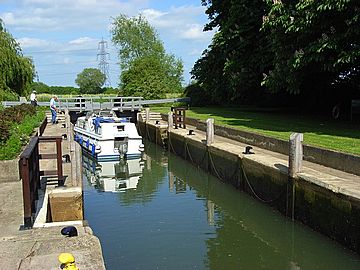Grafton Lock facts for kids

Grafton Lock
|
|
| Waterway | River Thames |
|---|---|
| County | Oxfordshire |
| Maintained by | Environment Agency |
| Operation | Manual |
| First built | 1896 |
| Length | 34.59 m (113 ft 6 in) |
| Width | 4.59 m (15 ft 1 in) |
| Fall | 1.11 m (3 ft 8 in) |
| Above sea level | 223' |
| Distance to Teddington Lock |
118 miles |
Grafton Lock is a special kind of gate system on the River Thames in Oxfordshire, England. It helps boats travel smoothly along the river. The lock is located on the northern side of the river. You can find it between the villages of Kelmscott and Radcot. It's about 1 mile south of a small place called Grafton. The lock was built in 1896 by a group called the Thames Conservancy.
A weir is also part of this area. It is located on the other side of the lock island. Weirs help control the water level in the river.
The land around the lock is very important for nature. It's called Grafton Lock Meadow. This area is a Site of Special Scientific Interest. This means it is protected because of its special plants or animals.
A Look Back in Time: Grafton Lock's History
Before the current lock, there was an older type of weir here. It had a "flash lock." This was a simple gate that could be opened quickly. It let a rush of water carry boats over shallow spots. This old weir had many names, like Day's or Lower Hart's. The name Lower Hart's helped avoid confusion. There was another Hart's Weir further upstream. That one was later replaced by Eaton Footbridge in 1936.
The Thames Conservancy removed the old weir in 1869. People started talking about building a proper "pound lock" in 1892. A pound lock is the kind we see today. It has two gates that create a chamber. This chamber fills or empties with water. This allows boats to move up or down the river. The new Grafton Lock finally opened four years later, in 1896.
Visiting Grafton Lock
You can reach Grafton Lock in a couple of ways. One way is to walk along the riverbank. This is a nice way to see the scenery. You can also get there by car. There's a turning off Langley Lane that connects to the A4095 road.
Exploring the River Above the Lock
As you travel upstream from Grafton Lock, you'll see interesting places. On the southern bank of the river is Eaton Hastings. On the northern bank, you'll find Kelmscott. This is home to Kelmscott Manor. This historic house was once the country home of William Morris. He was a famous artist and writer.
Further along the river, you'll cross under Eaton Footbridge. This bridge marks a spot that used to have a weir and flash lock. That old system was there until 1936. You might also see places for boats to stop and tie up. These are called moorings. They show the area's long history with river travel.
The Thames Path is a long walking trail. It follows the northern bank of the river from Grafton Lock. This path continues all the way to Buscot Lock. It's a great way to explore the river on foot.

